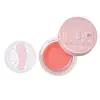What's inside
What's inside
 Key Ingredients
Key Ingredients

 Benefits
Benefits

 Concerns
Concerns

 Ingredients Side-by-side
Ingredients Side-by-side

Dimer Dilinoleyl Dimer Dilinoleate
EmollientTriethylhexanoin
MaskingHydrogenated Polyisobutene
EmollientStearic Acid
CleansingIsotridecyl Isononanoate
EmollientDiisostearyl Malate
EmollientSynthetic Wax
AbrasivePhytosteryl/Octyldodecyl Lauroyl Glutamate
Skin ConditioningSilica Dimethyl Silylate
EmollientPolyethylene
AbrasiveTocopherol
AntioxidantPolyglyceryl-2 Triisostearate
EmulsifyingArgania Spinosa Kernel Oil
EmollientButyrospermum Parkii Butter
Skin ConditioningCeramide NP
Skin ConditioningTetrahexyldecyl Ascorbate
AntioxidantHoney
HumectantSodium Hyaluronate
HumectantPetrolatum
EmollientButylene Glycol
HumectantWater
Skin ConditioningCitrus Sinensis Peel Extract
PerfumingTitanium Dioxide
Cosmetic ColorantCI 15985
Cosmetic ColorantCI 45380
Cosmetic ColorantBarium Sulfate
Cosmetic ColorantPotassium Hydroxide
BufferingDimer Dilinoleyl Dimer Dilinoleate, Triethylhexanoin, Hydrogenated Polyisobutene, Stearic Acid, Isotridecyl Isononanoate, Diisostearyl Malate, Synthetic Wax, Phytosteryl/Octyldodecyl Lauroyl Glutamate, Silica Dimethyl Silylate, Polyethylene, Tocopherol, Polyglyceryl-2 Triisostearate, Argania Spinosa Kernel Oil, Butyrospermum Parkii Butter, Ceramide NP, Tetrahexyldecyl Ascorbate, Honey, Sodium Hyaluronate, Petrolatum, Butylene Glycol, Water, Citrus Sinensis Peel Extract, Titanium Dioxide, CI 15985, CI 45380, Barium Sulfate, Potassium Hydroxide
Hydrogenated Polyisobutene
EmollientPolybutene
Dicaprylyl Carbonate
EmollientEthylene/Propylene/Styrene Copolymer
Hydrogenated Polydecene
EmollientEthylene/Propylene Copolymer
AbrasiveButylene/Ethylene/Styrene Copolymer
Water
Skin ConditioningParfum
MaskingOryza Sativa Bran Oil
EmollientPentaerythrityl Tetra-Di-T-Butyl Hydroxyhydrocinnamate
AntioxidantTocopherol
AntioxidantButylene Glycol
Humectant1,2-Hexanediol
Skin ConditioningCI 77491
Cosmetic ColorantPolyglyceryl-2 Triisostearate
EmulsifyingDipalmitoyl Hydroxyproline
Skin ConditioningOryza Sativa Extract
AbsorbentGlycerin
HumectantHydrogenated Rice Bran Oil
Skin ConditioningCaprylic/Capric Triglyceride
MaskingEthylhexylglycerin
Skin ConditioningHydrogenated Lecithin
EmulsifyingSodium Dna
Skin ConditioningCentella Asiatica Extract
CleansingSoluble Collagen
HumectantCollagen Extract
Skin ConditioningDisodium EDTA
Ginkgo Biloba Leaf Extract
Skin ConditioningCaprylyl Glycol
EmollientPolyglyceryl-10 Stearate
Skin ConditioningPhyllostachys Pubescens Shoot Bark Extract
Skin ConditioningHyaluronic Acid
HumectantAcetyl Hexapeptide-8
HumectantHydrolyzed Hyaluronic Acid
HumectantSodium Hyaluronate
HumectantHydrogenated Polyisobutene, Polybutene, Dicaprylyl Carbonate, Ethylene/Propylene/Styrene Copolymer, Hydrogenated Polydecene, Ethylene/Propylene Copolymer, Butylene/Ethylene/Styrene Copolymer, Water, Parfum, Oryza Sativa Bran Oil, Pentaerythrityl Tetra-Di-T-Butyl Hydroxyhydrocinnamate, Tocopherol, Butylene Glycol, 1,2-Hexanediol, CI 77491, Polyglyceryl-2 Triisostearate, Dipalmitoyl Hydroxyproline, Oryza Sativa Extract, Glycerin, Hydrogenated Rice Bran Oil, Caprylic/Capric Triglyceride, Ethylhexylglycerin, Hydrogenated Lecithin, Sodium Dna, Centella Asiatica Extract, Soluble Collagen, Collagen Extract, Disodium EDTA, Ginkgo Biloba Leaf Extract, Caprylyl Glycol, Polyglyceryl-10 Stearate, Phyllostachys Pubescens Shoot Bark Extract, Hyaluronic Acid, Acetyl Hexapeptide-8, Hydrolyzed Hyaluronic Acid, Sodium Hyaluronate
 Reviews
Reviews

Ingredients Explained
These ingredients are found in both products.
Ingredients higher up in an ingredient list are typically present in a larger amount.
Butylene Glycol (or BG) is used within cosmetic products for a few different reasons:
Overall, Butylene Glycol is a safe and well-rounded ingredient that works well with other ingredients.
Though this ingredient works well with most skin types, some people with sensitive skin may experience a reaction such as allergic rashes, closed comedones, or itchiness.
Learn more about Butylene GlycolHydrogenated Polyisobutene is a synthetic polymer. Polymers are compounds with high molecular weight. Hydrogenated Polyisobutene is an emollient and texture enhancer.
In one study, Hydrogenated Polyisobutene showed better skin hydration levels than Caprylic/Capric Triglyceride. As an emollient, it helps keep your skin soft and hydrated by trapping moisture in.
Hydrogenated Polyisobutene is often used as a mineral oil replacement.
Learn more about Hydrogenated PolyisobuteneThis ingredient is a form of glycerin with emulsifying and emollient properties.
As an emulsifier, this ingredient helps keep products together while adding a thick texture. The manufacturer states this ingredient has emollient properties. Emollients help keep the skin hydrated by trapping moisture in.
Polyglyceryl-2 Triisostearate is created by reacting diglycerin and isostearic acid. Due to the isostearic acid base, it may not be safe for Malassezia or fungal acne.
Learn more about Polyglyceryl-2 TriisostearateSodium Hyaluronate is hyaluronic acid's salt form. It is commonly derived from the sodium salt of hyaluronic acid.
Like hyaluronic acid, it is great at holding water and acts as a humectant. This makes it a great skin hydrating ingredient.
Sodium Hyaluronate is naturally occurring in our bodies and is mostly found in eye fluid and joints.
These are some other common types of Hyaluronic Acid:
Learn more about Sodium HyaluronateTocopherol (also known as Vitamin E) is a common antioxidant used to help protect the skin from free-radicals and strengthen the skin barrier. It's also fat soluble - this means our skin is great at absorbing it.
Vitamin E also helps keep your natural skin lipids healthy. Your lipid skin barrier naturally consists of lipids, ceramides, and fatty acids. Vitamin E offers extra protection for your skin’s lipid barrier, keeping your skin healthy and nourished.
Another benefit is a bit of UV protection. Vitamin E helps reduce the damage caused by UVB rays. (It should not replace your sunscreen). Combining it with Vitamin C can decrease sunburned cells and hyperpigmentation after UV exposure.
You might have noticed Vitamin E + C often paired together. This is because it is great at stabilizing Vitamin C. Using the two together helps increase the effectiveness of both ingredients.
There are often claims that Vitamin E can reduce/prevent scarring, but these claims haven't been confirmed by scientific research.
Learn more about TocopherolWater. It's the most common cosmetic ingredient of all. You'll usually see it at the top of ingredient lists, meaning that it makes up the largest part of the product.
So why is it so popular? Water most often acts as a solvent - this means that it helps dissolve other ingredients into the formulation.
You'll also recognize water as that liquid we all need to stay alive. If you see this, drink a glass of water. Stay hydrated!
Learn more about Water